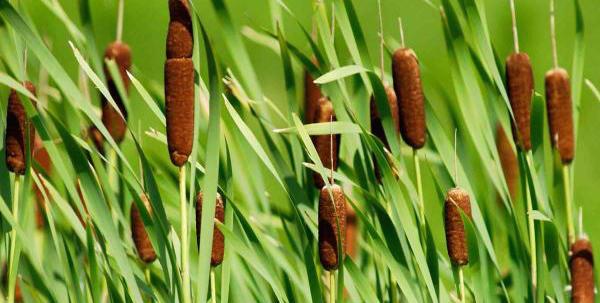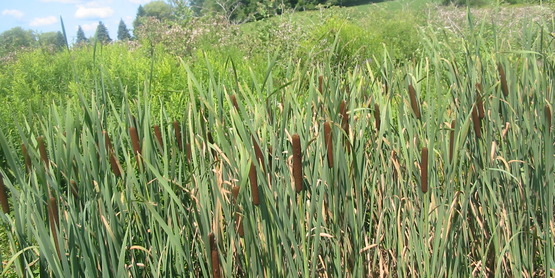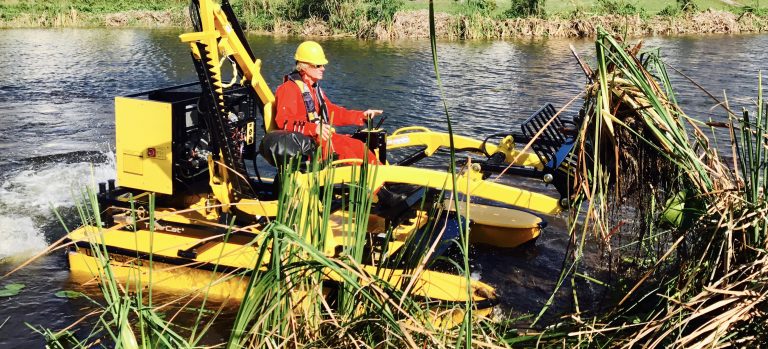Worst Water Weeds: Cattails
Most people call them cattails, although you’ll come across those who refer them as “punks” or even as “corn dog grass.” If you happen to be British, you’re more likely to call them “bulrushes” or “reedmace.” They are members of the scientific family of Typhaceae, large marsh plants sporting the telltale brownish compact “flower” that some think looks like a hot dog or sausage. They are one of the most common plants you’ll find in the northern hemisphere in wetlands like marshes and ponds. And therein lies the problem. Unlike some of the other worst water weeds I’ve written about here, cattails are not exotic. They are native and meant to be part of the wetland ecosystems where they occur. But just because they’re native doesn’t mean they aren’t invasive.
This is where it’s useful to mention what we mean by the word “weed.” The simplest definition is this: A weed is any plant growing in a place where you don’t want it. Having a few cattails on the edge of your favorite pond is no big deal. But under the right conditions, cattails can spread quickly and become problematic.
This is where it’s useful to mention what we mean by the word “weed.” The simplest definition is this: A weed is any plant growing in a place where you don’t want it. Having a few cattails on the edge of your favorite pond is no big deal. But under the right conditions, cattails can spread quickly and become problematic.

An infestation of cattails
- Scientific Name: Typha (genus). There are about 30 different species of cattails. Two common species in the USA are broad leaved cattail (T. latifolia) and narrow leaf cattail (T. angustifolia).
- Origins: Cattails are native throughout the northern hemisphere.
- Habitats: Various wetland ecosystems like marshes and pond edges are their preferred habitat. They vary in height from three to ten feet. They spread through two methods –when the brown hotdog-looking flower turns into a fluffy seed head, and also by their thick white rhizome roots.
- Eco-Impacts: If you’re a pond owner, you may have good reason to view cattails with uncertainty. When the cattails have the opportunity to grow aggressively, their stands can become impenetrably thick, blocking your view and threatening to take over the whole pond, which they can do because cattail beds can extend their hefty rhizomes far out into the water and actually float above deeper waters the plants would otherwise avoid. Besides the aesthetic and logistical problems a cattail infestation can cause, they can also crowd out other important native species. This kind of infestation is probably the result of nutrient levels being too rich in the water, which could be the result of human activity. Find out what’s happening around the body of water in question to see if you can discover a source of nutrients that is over-fertilizing the wetland.
- Controls: Mechanical removal or burning the stalks, followed by prolonged flooding; chemical herbicides.

Cattails taking over
Removing Cattails with Weedoo Environmental Work Boats

The Weedoo TC 3000 series can tackle your cattail infestation
Most people don’t want to dump a bunch of chemicals on their pond or other wetlands to get rid of an infestation of cattails. You simply don’t know what other kinds of damage you may be causing to the whole ecocystem you’re trying to protect and enjoy. A great way to tackle a cattail invasion is using a Weedoo Environmental Work Boat such as the TC 3000 series.
The TC 3000 series features a fluid-controlled PowerPack gasoline engine with triple pump hydraulics, twin-drive Trim-n-Tilt TC 3000 series propulsion, a work implement deck mounting rack and stanchions. Also featured on the TC 3000 series is a full operator station with helm control, premium marine seat, adjustable footrest, marine bucket loader, quick-change material handling marine bucket and hi-speed boom cutter for continuous cutting.
Ready to tackle those wily water weeds without chemicals? Contact Weedoo today!
The TC 3000 series features a fluid-controlled PowerPack gasoline engine with triple pump hydraulics, twin-drive Trim-n-Tilt TC 3000 series propulsion, a work implement deck mounting rack and stanchions. Also featured on the TC 3000 series is a full operator station with helm control, premium marine seat, adjustable footrest, marine bucket loader, quick-change material handling marine bucket and hi-speed boom cutter for continuous cutting.
Ready to tackle those wily water weeds without chemicals? Contact Weedoo today!
